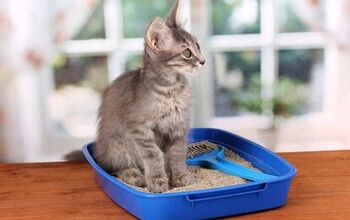What is the Best Litter for My Cat? Understanding Litter Types

The litterbox is often an afterthought for many of us, something that’s obviously necessary, but we overlook that it’s a cornerstone to our cat’s physical and mental well-being. Your cat’s litter box is important, including every detail that goes into it!
A positive litter box experience is far more significant than simply a place to do their business. It directly impacts their hygiene, comfort, and even their overall behavior. Just as we appreciate a clean and comfortable bathroom, our cats have their own standards. Have you ever walked into a public washroom only to feel like you should just back away slowly?
When setting up your cat’s litter box, there are several factors you should consider, one of which includes the type of litter. It’s easy to assume all litters are created equal, but the reality is that a world of different options, materials, and formulations exist, each with its own pros and cons.
This guide will explain the differences between the many types of cat litter and help you find the perfect match for your cat to ensure a happy and accident-free home.
Why Does Litter Choice Matter So Much?
Choosing the right litter for your cat goes beyond simply providing a place to do their business. From a hygiene and health perspective, the right litter is an essential piece of the puzzle in providing a clean and healthy environment both for your cat and the rest of the household. The right litter choice will efficiently absorb moisture, limiting the growth of bacteria, preventing tracking through your home, and reducing unpleasant odors.
Beyond the practicalities of basic cleanliness, there are behavioral impacts of your choices relating to your cat’s litter box. Cats can be surprisingly picky about the finer details of their litter, including the texture and the scent. Providing them with litter that doesn’t fit their personal preferences can lead to litter box avoidance and accidents in the home.
For environmentally-conscious cat parents, it’s also worth noting that each litter option carries a different environmental footprint. From production to disposal, they each affect your impact on the environment differently.
Finally, let’s not forget your convenience. While your cat’s happiness is the first priority, if you are down to a few options and one works better for you and your lifestyle, it makes sense to go in that direction. After all, a litter that’s difficult to manage or pushes the boundaries of your budget may not be an ideal long-term solution, regardless of how your cat feels about it.
Exploring the Different Types of Cat Litter
There are a surprising number of different cat litter materials and formulations to choose from. Standing in your local pet store, looking at all the options, you may be feeling overwhelmed. Let’s look at the nuances of each type, including its pros and cons, to help you better understand the impact on your cat’s comfort and your own convenience, making it easier than ever to choose the best cat litter for your home.
Clay Litter
The best-known and most widely used liter solution, clay litter is a popular choice among cat parents. It’s primarily available in two types: clumping and non-clumping.
Clumping clay litter is made from bentonite clay, a material with an incredible ability to absorb moisture and form solid, scoopable clumps when exposed to urine and feces. This clumping action makes daily cleaning of the box much easier, as you can easily remove the soiled portions while leaving the clean litter behind for future bathroom breaks. This makes it more budget-friendly than other solutions, as you only have to throw away the used litter.
Non-clumping clay litter is similar in that it is made from clay, but while it still absorbs the moisture, the clay does not form clumps. This can make cleanup a little more challenging as there are no easy clumps to remove. However, for young kittens, cats with PICA, or homes with dogs who may get into the box, the lack of clumping makes it a safer option that is less likely to cause a life-threatening blockage if consumed.
It's worth noting that when choosing a clay litter, there are different textures, ranging from fine, sand-like litter to coarser particles. Some cats will have strong preferences related to texture, so pay attention to their digging and covering habits.
Another variation that could turn your cat off is scented litter. While these scents may help mask odors, we must remember that our cats have a stronger sense of smell and are more sensitive to scents like these. Feeling overwhelmed by it, they may avoid the litter box entirely, leading to more accidents around the house.
While clay litters are widely available and generally more cost-effective, they have some drawbacks. These litters can be quite dusty, which can be a concern for cats or cat parents with respiratory sensitivities. They are also generally heavier to carry. Finally, they are not biodegradable, meaning they contribute to landfill waste.
Silica Gel (Crystal) Litter
This type of litter is composed of small silica gel beads that act like tiny sponges, absorbing a surprising amount of litter while trapping odors. For this reason, one significant advantage of silica gel litter is its ability to control or eliminate odor, often doing so better than any clay litter product. It’s also incredibly lightweight, making it easy to carry, handle, and pour. Because the litter absorbs moisture so effectively, you can go longer between full litter box changes.
While it may seem that fewer litter box changes would translate to considerable cost savings, this, unfortunately, isn’t the case due to the higher upfront costs. Some cats may also find the texture of the crystals or the slight crunching sound they make when stepped on to be uncomfortable or bothersome, which could turn them off using the box. My overly sensitive cat Pippen refuses to step on any form of silica gel litters I have tried in the past.
Plant-Based Litters
With a growing interest in making environmentally conscious choices in our lives, including when it comes to pet care, it’s no surprise that plant-based litter has been gaining a great deal of attention in recent years. These litters are generally pricier than clay litters, but they offer a wide variety of benefits.
Pine litter is a popular alternative, typically made from heat-treated pine wood. You can find pine litters in various forms, depending on your cat’s preferences, including pellets, shavings, and even clumping varieties. This is a much more sustainable choice as it is biodegradable. It often has a natural pine scent, which may appeal to cat parents looking to eliminate odor. However, like scented clay litters, this smell may be off-putting to some cats.
Corn litter is made from dried and processed corn kernels, making it another biodegradable option that typically offers good clumping abilities. Many cat parents also report that this is a great option for those looking for natural odor control without the need for bothersome scents. Plus, it’s lightweight, making it easier to handle. On the downside, if corn litter is not stored correctly, it may attract pests who are tempted to nibble on the kernels.
Wheat litter is crafted from processed wheat and is well known for its clumping abilities and decent odor control. It’s biodegradable and less dusty than most clay litter options. Like corn litter, this is a litter solution that will require careful storage to avoid attracting pests. Additionally, some cats with allergies have been found to react negatively to it.
Walnut shell litter is made from ground-up walnut shells, creating another biodegradable litter option with good odor control. This option stands out to many cat parents because it is lower in dust. The darker color of the litter can make cleanup a little more challenging as the urine spots are less noticeable. Plus, the unique texture of a walnut shell litter may not appeal to all cats.
Finally, grass seed litter is a newer option for plant-based litter that many cat parents are not yet familiar with. It offers many benefits, including low dust, lightweight feel, good odor control, and biodegradability. However, being newer, it is not as widely available, and its long-term effectiveness is still being tested by most cat parents I know who are trying it.
Paper Litter
I first discovered paper litter when searching for an option for Pippen and her sensitive paws. It’s also an excellent option for senior cats or those who are recovering from surgery or paw-related injuries. Made from recycled paper, it generally comes in two forms – pellet or shredded.
Paper litter is highly biodegradable, lightweight, and low in dust. Plus, the light color of paper litter can make it easier to monitor your cat’s urine output or any changes in urine color, making it helpful for tracking their health. Unfortunately, paper litter is generally less effective at odor control. It also doesn't clump well, and shredded varieties can sometimes be messy, getting caught in your cat’s fur, tracking it easily outside the box and around your house.
How to Choose the Right Litter for Your Cat
Choosing the best cat litter often involves some detective work, as no two cats are exactly alike in their preferences. Here are a few tips and tricks to help you navigate this process and select the ideal option for your home:
Start with Something Familiar
If you are bringing a new cat into your home, try to find out what type of litter they were previously using. Once they get settled in, you can take note of their litter box usage and any signs that they may not be completely satisfied with the current option.
- Are they using it consistently and without hesitation?
- Do you notice any signs of aversion, such as excessive digging without elimination, perching on the edge of the box, or, most concerningly, eliminating outside of it?
- Are they regularly having accidents around your home?
These behaviors may indicate that they aren’t comfortable with the current litter, and you should try a new option.
Texture Preferences
Like us, cats have their own sensory preferences, and the feel of the litter under their paws can significantly influence their willingness to use the box. Some cats like fine, sandy textures that mimic soil, while others might prefer coarser granules or even pellets. How your cat digs and covers can offer clues about their preferred texture.
Odor Sensitivity
Cats have a highly developed sense of smell, and strong scents, including those added to litter to mask odors, can be overwhelming or even offensive to them. In most cases, an unscented litter is the safest bet when trying a new type. It’s also important to note that these scents aren’t often the most effective option for odor control – they may cover up smells, but a good liter should absorb and neutralize odors at their source.
Dust Sensitivity
Dusty litters can pose a significant health risk, especially for cats (and cat parents) with pre-existing respiratory issues like asthma or allergies. Inhaling fine dust particles can irritate the airways and trigger bad reactions. This is why many cat parents will prioritize low-dust or dust-free options.
Other Health Considerations
If your cat has a specific health condition, like kidney disease, your vet may recommend using a lighter-colored, non-clumping litter to help you monitor how often/how much they urinate or any changes in urine color or consistency. Similarly, soft and dust-free paper litter may be the ideal solution for cats recovering from surgery or injuries for a safe, healthy bathroom environment.
Multi-Cat Households
When there are multiple cats to consider, the decision can be more complex. With three cats in our house, they all have their own preferences and needs to factor into what products we choose. When selecting a litter for multiple cats, a neutral, unscented clumping variety is often a good starting point.
Pay careful attention to how many litter boxes you have available. It’s generally recommended to have at least one litter box per cat, plus one extra, to prevent competition and ensure each cat has a private and accessible space. If you have a cat like my girl Pippen, who is incredibly picky and sensitive, you may want to set up the litter box they use most often with their preferred litter while changing the other boxes to suit your remaining cats.
Trial and Error
Introducing or experimenting with a new litter should always be a gradual process. Abruptly switching litters can be stressful and may actually lead to litter box aversion even if they would have otherwise liked the new litter.
A recommended approach is the “two-box method,” where you offer your cat their old litter in one box and the new litter in another, side-by-side. This will allow them to explore the new option at their own pace. Monitor your cat over several days or weeks to identify trends and preferences.
Consult Your Veterinarian
Your vet knows your cat’s specific health history and behavioral patterns, meaning they can offer valuable personalized advice. This is especially important if you are encountering any litter box issues or if your cat has underlying health concerns.
A Happy Cat, A Happy (and Accident-Free) Home
Remember, the quest for the best cat litter is ultimately about understanding and catering to your cat’s unique needs and preferences. There is no black-and-white “right” answer. By carefully considering their habits, sensitivities, and health, you can make the right choice for your home.
A comfortable and appropriate litter box set up, with the right litter at its heart, is an essential piece of the puzzle when it comes to giving your cat the happy, healthy life they deserve.
Join the PetGuide community. Get the latest pet news and product recommendations by subscribing to our newsletter here.

Britt Kascjak is a proud pet mom, sharing her heart (and her home) with her “pack” which includes her husband John, their 2 dogs – Lucifer and Willow – and their 3 cats – Pippen, Jinx, and Theia. She has been active in the animal rescue community for over 15 years, volunteering, fostering and advocating for organizations across Canada and the US. In her free time, she enjoys traveling around the country camping, hiking, and canoeing with her pets.
More by Britt
























